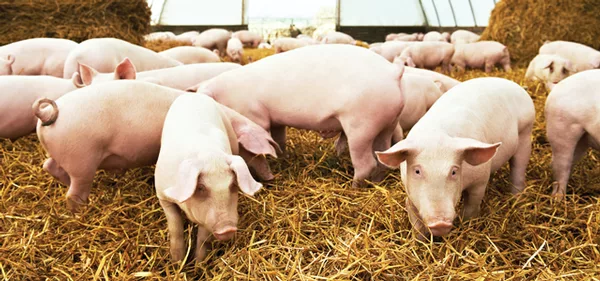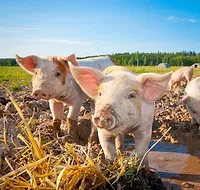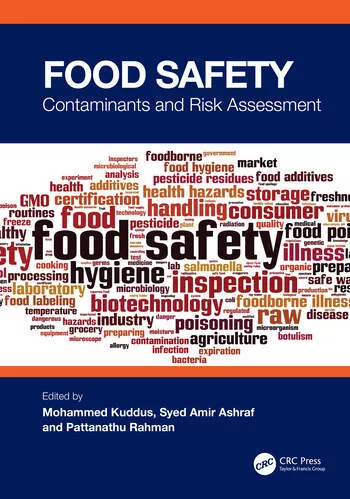Is African Swine Fever an Emerging Threat to the U.S. Pork Supply?

Once upon a time, livestock in this country were protected by two giants: the Atlantic Ocean and the Pacific Ocean. The slow rate of travel allowed the death or discovery of infected animals, and once those shipments arrived on these shores, strict import rules and zero tolerance prevented introduction of diseases once referred to as “exotic” or “foreign animal” diseases. These diseases are now called transboundary diseases.
Livestock in the U.S. have no genetic experience with—and therefore no resistance to—such infections, which can ruin production or cause death among all infected animals. What’s more, the U.S. has no vaccine stocks in reserve for these diseases. Today, global movements of livestock, game, or bush meat, as well as people, create new threats to animal industry in the U.S. (Table 1). State and federal governments struggle to control these incursions at the cost of millions of animals depopulated or killed.
One such disease is African swine fever (ASF), once largely found in Africa, which has become a chronic feature of swine agriculture in Eastern Europe and China. Given the large population of feral swine in North America, ASF may pose a significant threat to U.S. pork production. Ticks can be a vector for the ASF virus, and climate change enables more ticks to survive seasonal cycles and carry and spread infectious disease (Table 2).

The virus can persist for long periods in uncooked pig products and be transmitted to swine when they eat food waste. Families traveling internationally may bring traditional food gifts for important festivals such as Tet (the Asian New Year), which enables the spread of infectious agents and may introduce new species of ticks as potential vectors in the U.S. (Table 3). The introduction of ASF in the U.S. would stop all export of pork and have profound, deleterious effects on domestic pork production. Impacts include “Stop Transport” orders, depopulation of farms, and loss of confidence in domestic pork markets with an accompanying loss of consumer purchases.
Three classifications describe the spread of transboundary diseases:
1. Natural, wherein a disease travels with a migrating host;
2. Accidental, where a disease is introduced through error;
3. Or intentional for purposes of agri-terrorism and economic disruption, in the case of non-state actors, or as an act of aggression against an adversarial state. Although hard to prove, some suspect the foot-and-mouth disease outbreak in Taiwan in 1997 was such an incident.
History of ASF
ASF’s slow but apparently unstoppable 21st-century march began in 2007 in Georgia in Eastern Europe. The virus then spread through the countries of the former Eastern Bloc and into the Russian Federation states, reaching Ukraine in 2012 and Belarus in 2013. By 2014, ASF was in the Baltic states. In September 2018, ASF was identified in Belgium in two European boars, and Denmark is building a wild-boar-proof wall on its border with Germany.
ASF appeared in China in 2018, leading to the depopulation of some 600,000 swine. A total of 22 of China’s 23 provinces are infected,[1] including the major cities of Shanghai and Beijing. Tet will usher in the Year of the Pig and cause increased smuggling of pork-containing foods as people move across Asia and to North America to celebrate.
This slow ASF pandemic should have elicited a strong defensive posture in the U.S., with increased biosecurity efforts on swine-rearing operations and widespread public notification about the disease. ASF threatens U.S. swine rearing and export and also serves as a model of the complex challenges of disease control in a globalized market subject to the changes wrought by global warming.
European swine were brought to North America with Hernando de Soto in 1537, and escapees may have founded the feral swine population in the U.S. Feral swine number approximately 5 million and cause more than $1.5 billion in damage and crop losses each year. Feral swine are smart, cautious, and destructive, and no effective controls for them have been approved. Populations of feral swine inhabit much of the same territory as the soft ticks capable of spreading ASF.[2]
Why Is ASF Such a Threat?
The U.S. markets about 115 million hogs each year, for a gross income of about $20 billion. Pork exports were valued at $6.45 billion in 2017, amounting to 2.45 million metric tons. Domestic hog markets were devastated in 2013 by a pandemic of porcine epidemic diarrhea, which spread from Asia and Europe and demonstrated U.S. susceptibility to transboundary diseases. Five percent fewer hogs were slaughtered, although most of the production loss was recovered by growing the hogs longer and slaughtering them at a larger size.
ASF is spread by infected ticks of the genus Ornithodorus spp.[2] Recent discovery of the Asian longhorned tick in states along the Atlantic, as well as the discovery in the U.S. of Heartland and Bourbon viruses (also tick-borne) and the increased spread of Lyme borreliosis, suggests greater survival of ticks due to milder winters.
ASF is a hemorrhagic disease seen in swine of European origin, Sus scrofa, caused by a virus found in African swine such as the warthog, bush pig, and giant forest hog. None of these African swine show signs of clinical infection, nor do the native suids of North America (species of peccary). Clinical ASF presents in swine of any age with fever, rapid breathing, vomiting, diarrhea, and reddened patches on the skin, ears, or tail. Death can occur as a first sign or within 24–48 hours of onset of fever. In the U.S., the expected outcome would be death of all members of the herd, although a small number might survive and become silent carriers. Thus, depopulation of infected and contiguous premises is a required step in control.
The ASF virus survives in tissues, including some preserved meats, for as long as 30 days. The virus can be spread from pig to pig, tick to pig, or food/feed to pig. Thus, a possible scenario for establishment of ASF in the U.S. might look like this: An infected animal is used to produce sausage or chorizo overseas, the product is smuggled into the U.S., and remnants are consumed by domestic or feral swine. The feral swine could then communicate directly with farmed swine through a fence, or provide infected ticks that migrate to pastures where farmed swine graze.
The preferred management of ASF is prevention through monitoring in the country of origin and surveillance of swine overseas, along with import and vector control, biosecurity measures including double fencing, control of ectoparasites, and elimination of feral swine.[3] Denmark has proposed a boar-proof wall on its border with Germany to prevent entry of infected animals. A proposal to eliminate the wild boar population in Poland, however, sparked protests over ecological disruption and loss of the major component of the European wolf’s diet.
Perhaps the only certain outcome of an ASF outbreak in the U.S. is that all pork exports (approximately 2.45 million metric tons) would be curtailed at a loss of $6.5 to $7 billion. The duration of import bans would vary based on the time the U.S. needed to eradicate the disease, as well as the time required for complete decontamination of the agricultural premises. Additional time would be required for restocking and to resume production of feeder hogs.
However great the efforts at eradication, there is the distinct chance that pockets of infected animals would persist. Although ASF was eradicated from Haiti in 1984 and Cuba in 1980, it has become endemic in Sardinia since its introduction in 1982. Thus, the threat of a newly introduced disease becoming a feature of swine agriculture in the U.S. cannot be dismissed.
Consequences of ASF
Within the U.S., loss of pork production would depend on the extent of the outbreak, based on location and season. Swine-raising operations of more than 5,000 head are found in every state, and the major producers are collocated with the feed sources in the Midwestern grain belt. The southern edge of the dense commercial hog industry overlaps the northern edge of the feral swine and soft tick populations, increasing the chance for transmission from feral swine to commercial swine (Figure 1). This overlap also increases chances for establishing a chronically infected feral swine population that would extend the epidemic, perhaps making ASF endemic..png)
The hard freeze of winter decreases the tick population and may well curtail transmission of ASF, as seen with other arthropod-borne diseases. However, the prevalence of Lyme borreliosis has increased, perhaps because of the increased survival of tick vectors due to global warming. The global warming factor increases the difficulty of projecting the actual course of ASF control.
The most optimistic chronology for returning to production would be the time needed to depopulate and disinfect the premises, plus the 30 days the premises are required to remain empty and the time needed for sentinel animals to remain disease- or antibody-free. That easily adds up to 2 months. If pregnant sows are then restocked, the interval increases to 114 days for gestation and 6 months until the pigs are market-ready. Thus, afflicted producers and those in contiguous depopulated properties, as well as growers in quarantined counties, could be unprofitable for about a year.
This is in stark contrast to the resolution of the 2013 porcine epidemic diarrhea (PED) outbreak in the U.S., in which growers were encouraged to expose sows quickly so that they developed natural antibodies to the virus and passed that protection to several generations of offspring. However, PED ultimately spread to 31 states and reduced the crop of feeder pigs by 10%, without halting operations. An outbreak of ASF of similar extent would cripple swine rearing in the U.S. for many months.
Five factors contribute to the threat of an outbreak of ASF in the U.S.: globalization and exchange of people and foods; climate change; growing numbers of feral swine; introduction of new soft-tick vectors; and uncontrolled spread of ASF from its natural reservoir.
Current Efforts to Exclude ASF
The U.S. Department of Agriculture (USDA) and U.S. Customs and Border Protection have enhanced their readiness and defensive stance against ASF.[4] Federal agencies are working with Canada and Mexico, as well as agriculture agencies in all 50 states, to provide surveillance and enhance biosecurity. Airports most likely to be points of entry for smuggled pork products will have increased inspection and will use more detector dogs to sniff out animal products. And, of course, import of pork and animal-derived products from infected nations will be prohibited.
Stock prices for U.S. fast-food providers[5] and for animal protein producers have been driven down by the threat of ASF, and the shortage of pork in China may drive global prices up by 2–3%. Demand for soybeans for tofu may increase, but soybeans used for swine feed will decrease sharply.
Manufacturers of agriculture equipment and feed producers may also be adversely affected. In China, pork prices have not yet soared as producers slaughter inventory in anticipation of outbreaks. However, reports indicate that China will lose one-third of its swine herd and prices will increase sharply in late 2019.
Where Do We Go from Here?
Federal agencies must institute heightened inspection of incoming luggage to detect smuggled food that can serve as a source of ASF, and must inform swine veterinarians and growers of the imminent danger posed by this growing epidemic. Already ASF-contaminated pork products have been confiscated from luggage inspection at international airports, thus demonstrating the layers of cooperation needed to protect our agriculture. Customs and Border Protection, U.S. Food and Drug Administration, and USDA are the most easily recognized participating entities.
Although there is no chance of human infection, and therefore no public health impact, the public has an aversion to animal depopulation and carcass disposal. It leaves farmers emotionally distraught, family life is disrupted, and the cohesion of farm communities suffers. For every eight farms that close, a business in the local community fails. Thus, on-the-farm events penetrate the health of their close communities.
Kenneth E. Nusbaum, D.V.M., Ph.D., is professor emeritus of the Future Laboratory at Auburn University.
References
1. www.abc.net.au/news/2018-12-18/african-swine-fever-spreads-across-china-pork-prices-to-rise/10626688.
2. www.marketplace.org/2018/06/06/economy/feral-swine-are-most-invasive-animal-well-ever-see.
3. veterinaryrecord.bmj.com/content/178/11/262.
4. www.aphis.usda.gov/animal_health/emergency_management/downloads/asf_strategies.pdf.
5. www.cnbc.com/2019/05/24/analysts-fear-african-swine-fever-will-hit-these-stocks.html.
Looking for quick answers on food safety topics?
Try Ask FSM, our new smart AI search tool.
Ask FSM →








